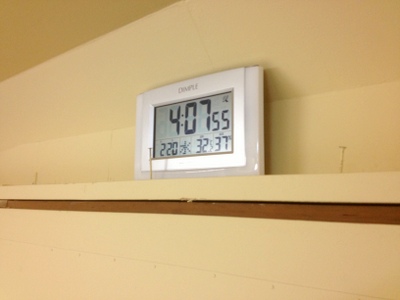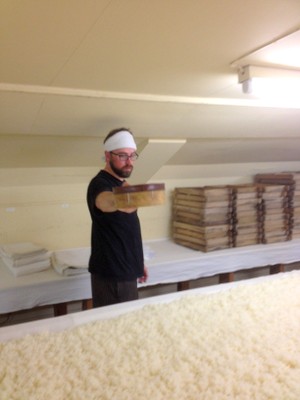It’s 3:15am and my alarm is going off. Something is wrong, and it takes me a few dazed seconds to pin-point exactly what the problem is.
The problem is it’s 3:15am and my alarm is going off. This means it’s time to go to work.
I’m in a hotel fifteen minutes walk from the Kozaemon brewery in 
I arrive at the brewery at 4am to find everybody already working in the muro, (the kouji-room) moving the kouji-rice around to ensure a standard temperature, and therefore the standard propagation of enzymes and sugars critical to a good sake. This particular job takes just over 45 minutes. It’s about 32c inside the muro with humidity around 60%, slightly below freezing outside, so when we leave the room it’s a mad dash to put the warm clothes back on and then get back to the break room for a power nap.

At least I’m providing some comic relief.
Next it’s time for what is called ‘Tome-shikomi’, the last stage of additions before the mash is left to ferment its way to sake. With each stage of shikomi, and there are three additions in all, the volume in the tanks roughly doubles. What this means is the Tome stage is the most exhausting. About 30 minutes of mixing and mashing the batch with a long pole and I’m finally done. My shoulders and arms are going to kill me tomorrow, that’s for certain.
After some other jobs, a lot of cleaning and washing, it’s back to the break room for breakfast. Four hours work down and it’s only 8am.
The rest of the day is much the same. Into the heat and humidity of the muro to mix, check, and adjust the kouji, out into the day where the temperature has crept up to 5 or so degrees, soaking the rice to the second to make sure the moisture content of the grains is at the optimum percentage, preparing for the next batch of steaming, preparing for the next job, cleaning up after the last, back to the muro, snatching little naps if the opportunity arises, until 11pm finally arrives and it’s time to finish for the evening.
17 hours. They do this every day. I mentioned in another column how hard the brewers work, how long their hours were, but I’m afraid I actually underestimated it. The Kouji guy at Amabuki, though he doesn’t pull the same shifts at the people at Kozaemon, hasn’t had a day off in seven months. The head brewer at Kikuyoi doesn’t sleep for longer more than two and half hours a night over the brewing period because every ninety minutes he checks and adjusts the kouji. The brewers at Mioya go days without stepping outside of the building.
This is not a job, it’s a calling. It’s a way of life, and that is why the sake tastes so good.
It’s not a product.
It’s art in a bottle.
………………………………………………………………………………………………………………………………………………………………………
 |
Wayne Shennen According to Wayne Shennen, good bartending is all about balancing flavours. “The subtlety of each ingredient should shine through,” explains the passionate New Zealander, a trained sake sommelier and one of Sydney’s most respected bartenders at award-winning Saké Restaurant & Bar. “If you can taste what you’re drinking, you tend to treat alcohol with more respect.”a Having earned his stripes behind bars in Sydney and the UK, Wayne is now gaining a following of fans who appreciate his original cocktail mixes and extensive knowledge of sake and shochu. “At Saké Sydney I’m given free reign to play – our bar staff all have a great knowledge of classic cocktails and we use this as the basis for getting innovative. We also have access to the world’s finest sake and shochu varieties,” says Wayne. “My goal is to make Saké famous for its drinks!” |
Saké Restaurant & Bar
12 Argyle Street, The Rocks, Sydney
T. 02 9259 5656
The Sake Alchemist #6
The Sake Alchemist #5
The Sake Alchemist #4
The Sake Alchemist #3
The Sake Alchemist #2
The Sake Alchemist #1
Tasting Business at Saké Restaurant & Bar




